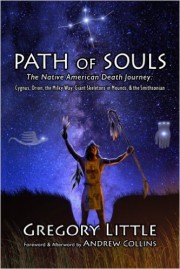
Marietta, Ohio's 2,000 year old mounds and earthworks were erected to help souls reach the stars. Ancient Native Americans designed the layouts of mounds in ways that pointed to key constellations.
Marietta, Ohio, February 3, 2016 (Newswire.com) - The Marietta, Ohio earthworks are generally considered to be one of the three largest sets of earthworks constructed by Native Americans in prehistoric times. The site was erected at the confluence of the Muskingum River at the Ohio River around 100 B.C.E. Two large earthen squares (formed by linear embankments of earth) dominated the site. The largest square enclosed 50 acres and had four large truncated mounds on its interior along with other features. On the southwest side of the square, toward the Muskingum River, an opening was made. From the opening a 150-foot wide, graded, ceremonial walkway led down to the river. The walkway extended nearly 700 feet and had outer walls of earth enclosing it on each side that were an astounding 10-20 feet high. On a high bluff on the other side of the Muskingum River were several small stone mounds. The walkway is known as the “Sacra Via” (sacred way).
The second square was on the southeast side of the larger square and enclosed 27 acres. A large, 30-foot high conical burial mound, enclosed by a wide and deep moat, was constructed on the outside of this square further to the southeast and had several long linear embankments aligned to it. One linear embankment led from this “Conus” mound into the square.
all of the necessary elements of the Path of Souls journey were present at ancient Marietta. One of the key elements of the path of souls journey present at both Portsmouth and Marietta involves the location of the rivers and the western alignment to Orion.
Dr. Greg Little
Prior research has shown that the Winter Solstice sunset was seen to occur on the high horizon on the other side of the Muskingum River from the largest square directly through pathway of the Sacra Via. The Winter Solstice sunrise was seen from the Quadranaou Mound in the large square directly across the large Conus mound.
Archaeological research in the mid-2000’s led to a near complete understanding of the beliefs about death that motivated the construction of such sites. In brief, America’s ancient Mound Builders—the Adena, Hopewell, and Mississippian cultures—believed in a journey of departed souls to the stars and beyond. The journey of the dead goes by the term “Path of Souls.” The soul’s journey had to take place in the Winter when the constellation of Scorpius was below the horizon and not visible. A video depicts all of the elements of this belief system.
The soul of the deceased made a journey to the west to a body of water. There, at night and before dawn, the soul took a leap into the sky aiming at Orion’s Nebula, just before it set into the western horizon. Orion’s Nebula was viewed as a portal to the sky world. From this portal the soul transitioned to the Milky Way where it continued the journey. The Milky Way was seen as a river of other souls making the same journey, but the soul eventually made it to a fork in the path. The fork was the Dark Rift of the Milky Way, at the Constellation of Cygnus. If the soul passed the tests encountered on the path, the soul was allowed to make a final journey out of the sky dome through a portal believed to be the star Deneb, the brightest star of Cygnus. British author Andrew Collins first proposed the significance of Cygnus in ancient cultures' beliefs about death.
Using the computer program Starry Night Pro, Dr. Greg Little, author of the Illustrated Encyclopedia of Native American Mounds & Earthworks, calculated stellar alignments at Marietta for the Winter Solstice in 100 B.C.E.
First, it was shown that Scorpius was below the horizon at night and was not visible. In addition, the Constellation of Cygnus was visible at nightfall and was seen to set at 8:30 on the northwest horizon in a direct line from the large Conus mound, through the adjacent square.
At the same time, Orion was seen to rise from the southeast at nightfall directly above the Capitolium mound from the Quadranaou mound in the large square. Finally, Orion was seen to set into the horizon before dawn on the horizon across the Muskingum River. At 2:20 AM Orion was just above the spot where the solstice sunset occurred directly down the path formed by the Sacra Via and within 10 minutes Orion is below the horizon. This would be the path taken by the departing soul when the leap to Orion’s Nebula was made.
Little wrote, "all of the necessary elements of the Path of Souls journey were present at ancient Marietta. One of the key elements of the path of souls journey present at both Portsmouth and Marietta involves the location of the rivers and the western alignment to Orion." In both cases, a body of water (the rivers) was on the southwest pathways aimed at the setting of Orion’s Nebula. It was important in the death journey that the leap to Orion’s Nebula occurred across water.
Share: